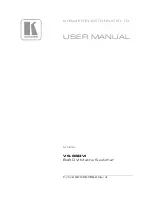
60
GigaX Series L2 Smart Plus Switch User Manual
8
Glossary
10BASE-T
A designation for the type of wiring used by Ethernet
networks with a data rate of 10 Mbps. Also known as
Category 3 (CAT 3) wiring. See also data rate, Ethernet.
100BASE-T
A designation for the type of wiring used by Ethernet
networks with a data rate of 100 Mbps. Also known as
Category 5 (CAT 5) wiring. See also data rate, Ethernet.
1000BASE-T
A designation for the type of wiring used by Ethernet
networks with a data rate of 1000 Mbps.
binary
The “base two” system of numbers, that uses only two
digits, 0 and 1, to represent all numbers. In binary, the
number 1 is written as 1, 2 as 10, 3 as 11, 4 as 100, etc.
Although expressed as decimal numbers for convenience,
IP addresses in actual use are binary numbers; e.g., the IP
address 209.191.4.240 is 11010001.10111111.00000100.111
10000 in binary. See also bit, IP address, network mask.
bit
Short for “binary digit,” a bit is a number that can have two
values, 0 or 1. See also binary.
bps
bits per second
CoS
Class of Service. Defined in 802.1Q, the value range is from
0 to 7. Due to 4 internal traffic class mapping to 8 priority,
Only Cos value 0,2,5,7 are valid according to Cos Queue
Mapping.
broadcast
To send data to all computers on a network.
download
To transfer data in the downstream direction, i.e., from the
Internet to the user.
Ethernet
The most commonly installed computer network technology,
usually using twisted pair wiring. Ethernet data rates are
10 Mbps and 100 Mbps. See also 10BASE-T, 100BASE-T,
twisted pair.
filtering
To screen out selected types of data, based on filtering rules.
Filtering can be applied in one direction (ingress or egress),
or in both directions.
filtering rule
A rule that specifies what kinds of data the a routing device
will accept and/or reject. Filtering rules are defined to operate
on an interface (or multiple interfaces) and in a particular
direction (upstream, downstream, or both).





































